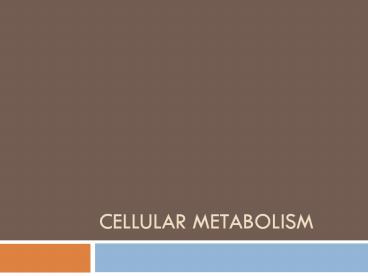Cellular Metabolism - PowerPoint PPT Presentation
Title:
Cellular Metabolism
Description:
CELLULAR METABOLISM * Transcription Protein Synthesis Translation At ribosome, mRNA is read by codons, 3 bases Amino acids are brought to the ribosome by the tRNA ... – PowerPoint PPT presentation
Number of Views:308
Avg rating:3.0/5.0
Title: Cellular Metabolism
1
Cellular Metabolism
2
Introduction
- Cells are the site of metabolic reactions
- Maintain life
- Enzyme controls each of the reactions
- Specific type of protein
3
Metabolic Reactions
- Anabolic building up larger molecules from
smaller ones - Materials for cell growth and repair
- Catabolic breakdown of larger molecules into
smaller ones - Release energy
4
Anabolism
- Dehydration Synthesis -OH and H from separate
molecules are removed forming H2O - join sugar molecules into chains forming glycogen
- Triglycerides in adipose cells
- Proteins from amino acids
- Peptide bonds
5
Dehydration Synthesis
6
Catabolism
- Hydrolysis decomposes carbohydrates, lipids, and
proteins - Splits water molecules
- C12H22O11 H2O ? C6H12O6 C6H12O6
- Sucrose water glucose fructose
- Occurs during digestion
- Carbohydrates ? monosaccharides
- Fats ? glycerol fatty acids
- Proteins ? amino acids
- Nucleic acids ? nucleotides
7
Hydrolysis
8
Control of Metabolic Reactions
- Most reaction require energy and a temperature
greater than the bodys - Enzymes promote chemical reactions
- Proteins that lower activation energy
- Energy needed to begin a reaction
- Catalysts
- Never consumed ? exist in small quantities
9
(No Transcript)
10
Enzymes
- Substrate particular chemical enzymes act on
- Catalaseenzyme hydrogen peroxidesubstrate
- Active Site site on an enzyme where substrate
binds - Lock and key
- Very specific
11
Insulin Degrading Enzyme
12
Enzyme Reaction
- ES? ES ? EP ? EP
- S Substrate
- E Enzyme
- P Product
- Reaction Rate increases with increased substrate
concentration
13
Factors that Alter Enzymes
- Denature protein structure fall apart and
becomes nonfunctional - Too high temperatures
- Radiation
- Electricity
- pH changes
- Certain chemicals
- Arsenic and Cyanides
14
Denatured Enzyme
15
Energy for Metabolic Reactions
16
Energy
- The capacity to change or move matter
- Ability to do work
- Heat
- Light
- Sound
- Electrical energy
- Mechanical energy
- Chemical energy
17
Release of Chemical Energy
- Chemical energy is held in bonds and released
when bonds are broken - Oxidation cell burning glucose
- Burning requires a large amount of energy to
begin - Enzymes lower the activation energy
- Most of the energy escapes as light or heat
- Carry molecules capture about half of the energy
- Remaining energy, heat, help maintain body
temperature
18
Glycolysis
- 1st step in cellular respiration
- Cytoplasm or cytosol
- Anaerobic Doesnt require oxygen
- Energy is used to synthesize 2 ATP
- 6-C glucose ?2 3-C pyruvic acid molecules
19
Aerobic Pathway
- Requires oxygen
- Occurs in the mitochondria
- Products CO2 H2
- CO2 diffuses out the cell
- H2 combine with O2 to form H2O
- Produces more 34 ATP
20
(No Transcript)
21
ATP vs. ADP
- ATP adenosine triphosphate
- 3 phosphates
- Fully charged battery
- Break last phosphate off ? release energy
- ADP adenosine diphosphate
- 2 phosphates
- Partially charged battery
- Energy phosphate ? store energy
22
Metabolic Pathway
- Anabolic and catabolic reaction happen in
particular sequence - Enzymes that control the reaction rates must also
act in a specific sequence - Enzymes are positioned in the exact sequence as
that of the reaction
23
Pathways
- Carbohydrates cellular energy source
- Cellular respiration
- Glycolysis? Citric Acid Cycle? Electron Transport
Chain - Half of the energy(E) ? ATP remaining E? heat
- Lipid phospholipids, cholesterol, triglycerides
- 2x E gram per gram than carb. And protein
- Beta Oxidation form ketone bodies that can be
used in the citric acid cycle - Acetone
24
(No Transcript)
25
Protein Pathway
- Amino acids are absorb and transported by the
blood to cells - Amino acids are reunited into cell parts
- Deamination amino acids have N removed
- Used in citric acid cycle
- By product urea
- liver
26
Metabolic Pathways
27
Nucleic Acids and Protein Synthesis
28
Genetics
- In the nucleus, DNA is housed
- information from parent to child
- Gene
- instruction for proteins
- Enzymes and control metabolic processes
29
Karyotype
30
DNA Molecule
- Double Helix
- Nucleotides
- Sugar phosphate backbone
- Nitrogenous bases in the middle
- A,T,G,C
- 2 strands bonded by H-bonds
- A pairs with T, and G pairs with C
- One DNA molecule millions of base pairs long
31
Genetic Code
- DNA specific nucleotide sequence
- Specifies a specific amino acid
- RNA molecules transfer information to cytoplasm
32
RNA
- Single stranded
- Contain uracil instead of thymine
- Contain ribose instead of deoxyribose
- mRNA messenger, carries a copy of a single gene
- rRNA composes ribosomes
- tRNA transfers amino acids
33
Protein Synthesis
- Transcription
- Single genes are coped into mRNA
- Sent into the cytoplasm to a ribosome
34
Transcription
35
(No Transcript)
36
Protein Synthesis
- Translation
- At ribosome, mRNA is read by codons, 3 bases
- Amino acids are brought to the ribosome by the
tRNA - Anticodons on the tRNA must match the codons on
the mRNA - mRNA UUA CGC AUC GAU
- tRNA AAU GCG UAG CUA
- Amino acid released from tRNA form a chain and
then a protein
37
(No Transcript)
38
(No Transcript)
39
DNA Synthesis
- Each cell needs a copy of DNA
- During interphase, the DNA is replicated
- The double helix unzip
- Hydrogen bonds break
- Bases are brought in to each strand
- Semiconservative each DNA molecule contains a
new and an old strand of DNA
40
DNA Replication































